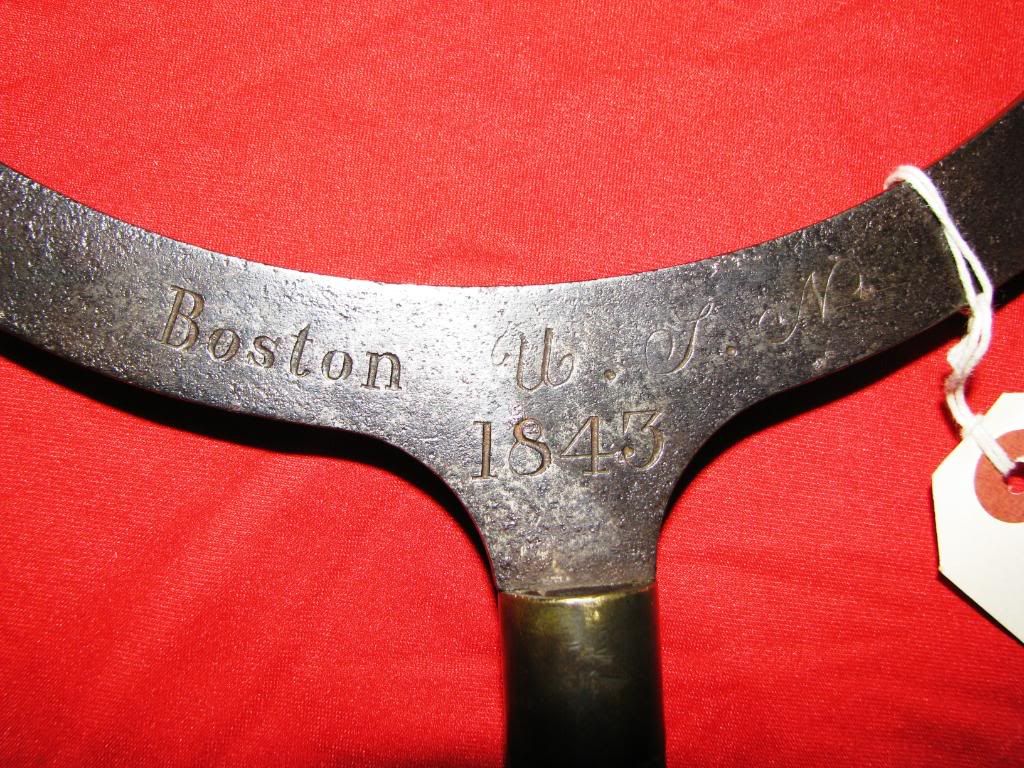This shell gauge is unusual due to its markings. Most Navy shell gauges I've seen were marked with some version of "USNYW" or "USNOYW" indicating their manufacture at the Washington Navy Yard, plus the year of manufacture and size. This one has "Boston" and "USN" over the year 1843, and I've never seen another shot or shell gauge with similar markings. I've had to do a lot of thinking about why this one is marked differently.
Here's my theory: The gauge wasn't manufactured until a year or two after all of the "10-inch guns of 86 hundredweight" were completed, so the gauge doesn't seem to have been an integral part of the "gun" program or it would have been built while the guns were being cast. I suspect the gauge was needed when Cyrus Alger of Boston, a very prominent iron founder, won a contract to supply 10-inch shells for the Navy (I haven't checked any contract records to verify the award of a shell contract to Alger.) Ordnance items such as guns, shot, and shells had to pass rigorous inspections conducted by experienced naval officers assigned to duty either at the contractor's facility or in the vicinity. That officer would need the proper tools to conduct the inspection. One of the basic tools for inspecting shells was the shell gauge, a steel ring with wooden handle. The shell would be rolled on a flat surface with the ring over it for a short distance to ensure it didn't "hang up." The shells for the 10-inch shell gun could not exceed 9.8 inches in diameter, so as to leave the proper "windage" between the bore and the shell. I suspect this gauge was manufactured specifically for the Navy Inspecting Officer at Boston, and marked appropriately. The Inspecting Officer who was assigned to Boston at the time the gauge was made seems to have been Alexander Scammell Wadsworth, who, coincidentally, inspected all Navy 10-inch guns of this pattern.
The size markings on the top of the ring, combined with the date, indicate it was made to inspect shells cast for the Navy 10-inch shell guns of 86 hundredweight. Thirty-three of these guns were cast by West Point foundry in 1841 and 1842, As the name indicates, they were designed to fire explosive shells only. The guns were bored with a 7-inch diameter chamber at the rear of the bore. Chambers were a feature of all "Phaixhans" shell guns, of which the Navy had two types at that time, the 8-inch and the 10-inch. These shell guns were intended for pivot mounting in specific ship classes. The 10-inch, hollow, spherical shell weighed 102 pounds and held a bursting charge of 4 pounds of black powder. The gun barrel was 112 inches long and weighed about 9700 pounds.
Unfortunately not a single Navy 10-inch shell gun nor carriage is known to survive, so it is possible that this gauge is the only remaining artifact associated with those early 10-inch shell guns.
If anyone has any other ideas on why this gauge is marked as it is, I'd like to hear them.
Other pix of gauge:
http://s17.photobucket.com/albums/b62/cannonmn/miscforumsetc/forums41/?action=view¤t=0ba9ae51.pbw